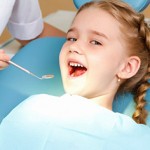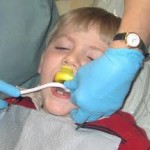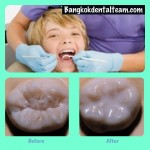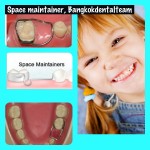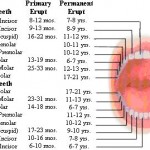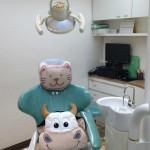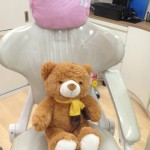-
Pediatric Dentistry
Peadodontics
We know very well that your kids’ teeth are very important to you,
and so are they to us! Please trust our pediatric dentists to help
treating your kids’ teeth for a better oral health.
Oral care should begin soon after birth. Gums should be cleaned after each feeding. You should begin brushing your child’s teeth as soon as they appear.
Permanent teeth start to come through around the age of six. This begins with the first molars and lower central incisors. This process continues until approximately age twenty-one.
Pediatric dentistry is a very gentle method of treatment which aims to make a visit to the dentist a more comfortable experience for your children. We have purpose built area specifically designed to make your children feel relaxed and at ease.
Peadodontics Dentistry, or Pediatric Dentistry, is concerned dental care and treatment for children.
Peadodontics treatment available in our clinic are:
-cleaning & polishing
-behavior management and dental education
-restorations and tooth-color filling of deciduous teeth
-root canal treatment
-crowns, stainless steel crowns
-fluoride application
-space maintainer/active plates
– dental check-up
-monitoring of the dental eruption
-child dietary consultation, fluoride treatment
-sealant of the permanent teeth
Fluoride good or bad?
Fluoride is an element, which has been shown to be beneficial to teeth. However, too little or too much fluoride can be detrimental to the teeth. Little or no fluoride will not strengthen the teeth to help them resist cavities. Excessive fluoride ingestion by preschool-aged children can lead to dental fluorosis, which is a chalky white to even brown discoloration of the permanent teeth. Many children often get more fluoride than their parents realize. Being aware of a child’s potential sources of fluoride can help parents prevent the possibility of dental fluorosis.
Some of these sources are:
- Too much fluoridated toothpaste at an early age.
- The inappropriate use of fluoride supplements.
- Hidden sources of fluoride in the child’s diet.
Two and three-year olds may not be able to expectorate (spit out) fluoride-containing toothpaste when brushing. As a result, these youngsters may ingest an excessive amount of fluoride during tooth brushing. Toothpaste ingestion during this critical period of permanent tooth development is the greatest risk factor in the development of fluorosis.
Excessive and inappropriate intake of fluoride supplements may also contribute to fluorosis. Fluoride drops and tablets, as well as fluoride fortified vitamins should not be given to infants younger than six months of age. After that time, fluoride supplements should only be given to children after all of the sources of ingested fluoride have been accounted for and upon the recommendation of your pediatrician or pediatric dentist.
Certain foods contain high levels of fluoride, especially: powdered concentrate infant formula, soy-based infant formula, infant dry cereals, creamed spinach, and infant chicken products. Please read the label or contact the manufacturer. Some beverages also contain high levels of fluoride, especially: decaffeinated teas, white grape juices, and juice drinks manufactured in fluoridated cities. Blending the syrup, carbonation with the city water supply often makes soft drinks at fast food restaurants – so if fluoride is in the water – this is another source.
Parents can take the following steps to decrease the risk of fluorosis in their children’s teeth:
- Use baby tooth cleanser on the toothbrush in the very young child.
- Place only a pea-sized drop of children’s toothpaste on the brush when brushing.
- Account for all of the sources of ingested fluoride before requesting fluoride supplements from your child’s physician or pediatric dentist.
- Avoid giving any fluoride-containing supplements to infants until they are 6 months old.
- Obtain fluoride level test results for your drinking water before giving fluoride supplements to your child (check with local water utilities).
Sealants are used to protect the chewing surfaces of the child’s back teeth. These surfaces often decay because they contain pits and fissures-tiny grooves and depressions, where plaque accumulates.
Sealants are clear or shaded plastic materials that can be painted onto these decay-prone surfaces of the teeth. By forming a thin covering over the pits and fissures, the sealants keep plaque and food out of the crevices in the teeth, reducing the risk of decay.
Sealants should be applied as the permanent teeth erupt. Ask your dentist if your child can benefit from sealants.
Space maintainer
space maintainer
If a baby tooth is lost prematurely, you may need a space maintainer to “save” the space. What does that mean? Baby teeth are there for a reason. One key reason is that they save space for the permanent tooth, which will erupt into its position when the baby tooth is lost normally.
How is the Eruption Of a Child’s Teeth?
Children’s teeth begin forming before birth. As early as 4 months, the first primary (or baby) teeth to erupt through the gums are the lower central incisors, followed closely by the upper central incisors. Although all 20 primary teeth usually appear by age 3, the pace and order of their eruption varies.
Permanent teeth begin appearing around age 6, starting with the first molars and lower central incisors. This process continues until approximately age 21.
Adults have 28 permanent teeth, or up to 32 including the third molars (or wisdom teeth).
| S | M | T | W | T | F | S |
|---|---|---|---|---|---|---|
| « Aug | ||||||
| 1 | 2 | 3 | 4 | 5 | 6 | |
| 7 | 8 | 9 | 10 | 11 | 12 | 13 |
| 14 | 15 | 16 | 17 | 18 | 19 | 20 |
| 21 | 22 | 23 | 24 | 25 | 26 | 27 |
| 28 | 29 | 30 | ||||
Tags
beautiful
Bleaching
braces
cleaning
damon
dental
Dental Implant
dental implants
dental substitution
denture
Endodontics
fixed denture
gum
Implants
orthodontics
Orthodontics
smile
teeth
Teeth Bleaching
Teeth Whitening
treatment
veneers
Whitening
ขูดหินปูน
ครอบฟัน
จัดฟันดาม่อน
จัดฟันเพื่อสุขภาพฟันที่ดี
ดัดฟัน
ดามอน
ทำความสะอาดฟัน
ปรึกษา
ฟอกสีฟัน
ฟันขาว
ฟันปลอม
ฟันปลอมติดแน่น
ฟันสวย
ฟันสีขาว
ยิ้มสวย
รากเทียม
วีเนียร์
สีฟัน
เคลือบฟันเทียม
เสียวฟัน
ใส่ฟัน
ใส่ฟันปลอม
